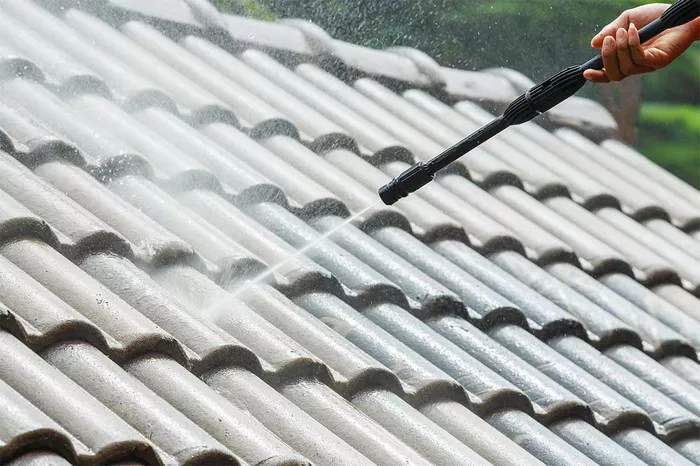Pressure washing is a highly effective method for cleaning various surfaces, including roofs. It involves using a high-pressure water spray to remove dirt, grime, mold, and other debris. When applied correctly, pressure washing can restore the appearance of a roof, increase its longevity, and enhance the overall curb appeal of a property. Compared to traditional cleaning methods, pressure washing is faster, more efficient, and requires minimal manual effort, making it a preferred choice for many homeowners.
Safety Precautions
Safety should be the top priority when pressure washing any surface, especially a roof. Before beginning the cleaning process, it is essential to wear appropriate safety gear, including goggles, gloves, and non-slip footwear. Additionally, make sure to use a sturdy ladder and have a spotter present to assist with stability. Be mindful of overhead power lines and avoid working near them to prevent electrocution hazards. Furthermore, never operate a pressure washer from a ladder, as it can lead to loss of balance and serious injuries.
Assessment of Roof Type
Before pressure washing a roof, it is crucial to assess the type of roofing material to determine if it can withstand the force of the water spray. While most asphalt shingle and metal roofs can handle pressure washing, delicate materials such as slate or tile may require alternative cleaning methods to prevent damage. Consult with a professional if you are uncertain about your roof’s suitability for pressure washing.
Equipment Overview
To pressure wash a roof effectively, you will need a few key pieces of equipment. The primary tool is a pressure washer, which generates the high-pressure water spray needed for cleaning. It is essential to use a pressure washer with an appropriate PSI (pounds per square inch) rating for roof cleaning to avoid causing damage. Additionally, different types of nozzles, such as a wide-angle nozzle for gentle cleaning and a narrow-angle nozzle for stubborn stains, can be attached to the pressure washer wand to adjust the spray pattern and intensity.
Preparation Steps
Before starting the pressure washing process, take time to prepare the area and ensure safety. Begin by removing any loose debris, such as branches, leaves, and twigs, from the roof surface using a broom or leaf blower. Clear gutters and downspouts to prevent clogging and ensure proper drainage during cleaning. Cover nearby plants, windows, and delicate surfaces with plastic sheeting or tarps to protect them from overspray and chemical runoff.
Pressure Washing Procedure
When pressure washing a roof, it is essential to maintain the correct angle and distance to avoid causing damage. Start by setting up the pressure washer on a stable surface and connecting it to a water source. Begin at the lowest point of the roof and work your way up, using smooth, overlapping strokes to ensure thorough coverage. Keep the nozzle at a consistent distance of 6 to 12 inches from the surface and adjust the pressure as needed to avoid dislodging shingles or tiles.
Post-Cleaning
After pressure washing the roof, take time to inspect the area for any signs of damage or loosened materials. Check for missing or damaged shingles, cracked tiles, or lifted flashing, and make repairs as necessary to prevent water infiltration and further deterioration. Dispose of any debris or runoff responsibly, following local regulations to minimize environmental impact.
Alternatives to Pressure Washing
If pressure washing is not suitable for your roof type or condition, there are alternative cleaning methods available. For example, soft washing involves using low-pressure water combined with eco-friendly cleaning solutions to gently remove stains and debris without causing damage. Manual cleaning with a scrub brush and mild detergent can also be effective for spot cleaning small areas.
Professional Help
When in doubt or dealing with complex cleaning tasks, it is always best to consult with a professional pressure washing service. Experienced professionals have the knowledge, skills, and equipment needed to assess your roof’s condition accurately and determine the most appropriate cleaning method. They can also handle challenging situations safely and efficiently, minimizing the risk of damage to your roof or property.
Maintenance Tips
To prolong the cleanliness and longevity of your roof, incorporate regular maintenance into your home care routine. Trim overhanging branches to prevent debris buildup and reduce the risk of damage from falling limbs. Clean gutters and downspouts regularly to ensure proper water drainage and prevent water damage to the roof and surrounding structures. Inspect the roof periodically for signs of wear and tear, such as cracked shingles, rusted flashing, or moss growth, and address any issues promptly to avoid costly repairs down the line.
Conclusion
In conclusion, pressure washing can be an effective method for cleaning roofs, but it requires careful preparation, proper equipment, and adherence to safety protocols. By following the guidelines outlined in this article and consulting with professionals when needed, homeowners can maintain clean, attractive roofs that enhance the overall appearance and value of their properties.

